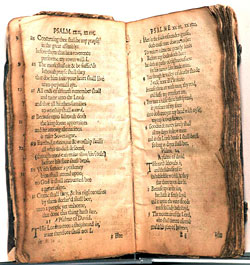Contemporary Jewish symbols shown in Holy, Cultural, and Historical Sights
1. -2. Western Wall/Wailing Wall/Kotel: This is a sacred place for the Jewish people. The wall is the piece of the outer wall of the Temple that was not destroyed. People visit the wall to pray to God and to put their prayers, written on scraps of paper, into the cracks of the wall. I included two pictures to show that the wall is divided by a screen (a side for men and a side for women). The orthodox Jews pray this way in temple and therefore the wall is set up this way as well. The Western Wall is symbolic in that is it all that is left of the Temple and therefore making it a very holy place to pray at.
3. Sign for King David’s Tomb: The Hebrew words on the sign show the language of the Jewish people. Also, the colors white and blue are symbolic for Judaism. The art decorating the border of the sign has Stars of David, which is the main symbol for Judaism. King David is important to the Judaism in that during his reign became the formation of a Jewish kingdom in Jerusalem (where his tomb is).
4. Prayer: The photograph shows a woman praying at the tomb of King David. She is covering her head (wearing a hat), which shows respect while in a temple or place where prayer or service is happening. Usually a male will wear a kippah to cover his head, which is a symbol seen in dress within a synagogue or in daily life for conservative and orthodox Jews, and woman will also wear a head covering (sometimes made of lace).
5.Mount Herzl Cemetery: The cemetery is the resting place for Israel Defense Force soldiers, prime ministers, presidents and other officials. The photograph shown is that of soldiers’ graves. On the headstones are small rocks which a traditional marking at Jewish cemeteries. When Jews visit the deceased, they put stones on the graves to leave a visible indication that the person has not been forgotten.
6. Theodore Herzl: He was a Zionist leader, referred as the father of the Zionist movement, in the late 1800s. “Zionism is the international political movement that originally supported the reestablishment of a homeland for the Jewish People in Palestine. The area was the JewishBiblical homeland, called the Land of Israel. Since the creation of Israel, the Zionist movement continues primarily as support for the modern state of Israel.” (Wikipedia- Herzl) He believed the Jews should form their own state, especially due to the large amounts of anti Semitism in Europe at the time. Herzl was a leader for the creation of the Jewish state and still today is a symbolic leader for preserving the state, even in difficult times.
7. Yad Vashem is the Holocaust memorial to the Jewish victims. Yad Vashem includes the Holocaust History Museum, various memorial sites, art, a synagogue, archives, a library, and an educational center. The Holocaust and Holocaust remembrance is very important to many Jews and this memorial is a sign of remembrance and respect to those who lived through the terrible oppression and to those who helped the Jews. The Holocaust in itself has become a symbol for the Jewish people because of the baggage it has and how widely effected Jews were. Today, Jewish people still feel connected to the Holocaust because of relatives that were directly affected and because in the history of religion, it is a fairly recent event that drastic affected a large amount of Jewish people.
8. Bagels: This type of bread is links with the Jews and is commonly eaten with cream cheese and lox. The history of the bagel does in fact have a connection to Judaism: “There was a tradition among many observant Jewish families to make bagels on Saturday evenings at the conclusion of the Sabbath. Due to Jewish Sabbath restrictions, they were not permitted to cook during the period of the Sabbath and, compared with other types of bread, bagels could be baked very quickly as soon as it ended.” (Wikipedia- Bagels). Today, the reason for bagels to be made and consumed by Jews is not the same, but there is still a symbolic connection.
9. Israeli Flag: The white flag has two blue strips and a blue Star of David in the center. The colors and the Star of David are all symbols of Judaism. The flag was actually designed after the Tallit, which is the prayer shawl worn during services in temple (another symbol seen in the way Jews dress).
10. Old Temple: This photography shows a miniature recreation/model of the Herod’s Temple, which was an expansion of the Temple in Jerusalem and the city around it (or what is may have looked like). People believe that the Temple was located on the current site of the Dome of the Rock. The Temple is an important symbol in Judaism because it is very present in the Jewish bible, where the Temple is said to be the center of ancient Judaism, and “According to classical Jewish belief, the Temple (or the Temple Mount) acts as the figurative "footstool" of God's presence in the physical world.” (Wikipedia- Temples in Jerusalem).















